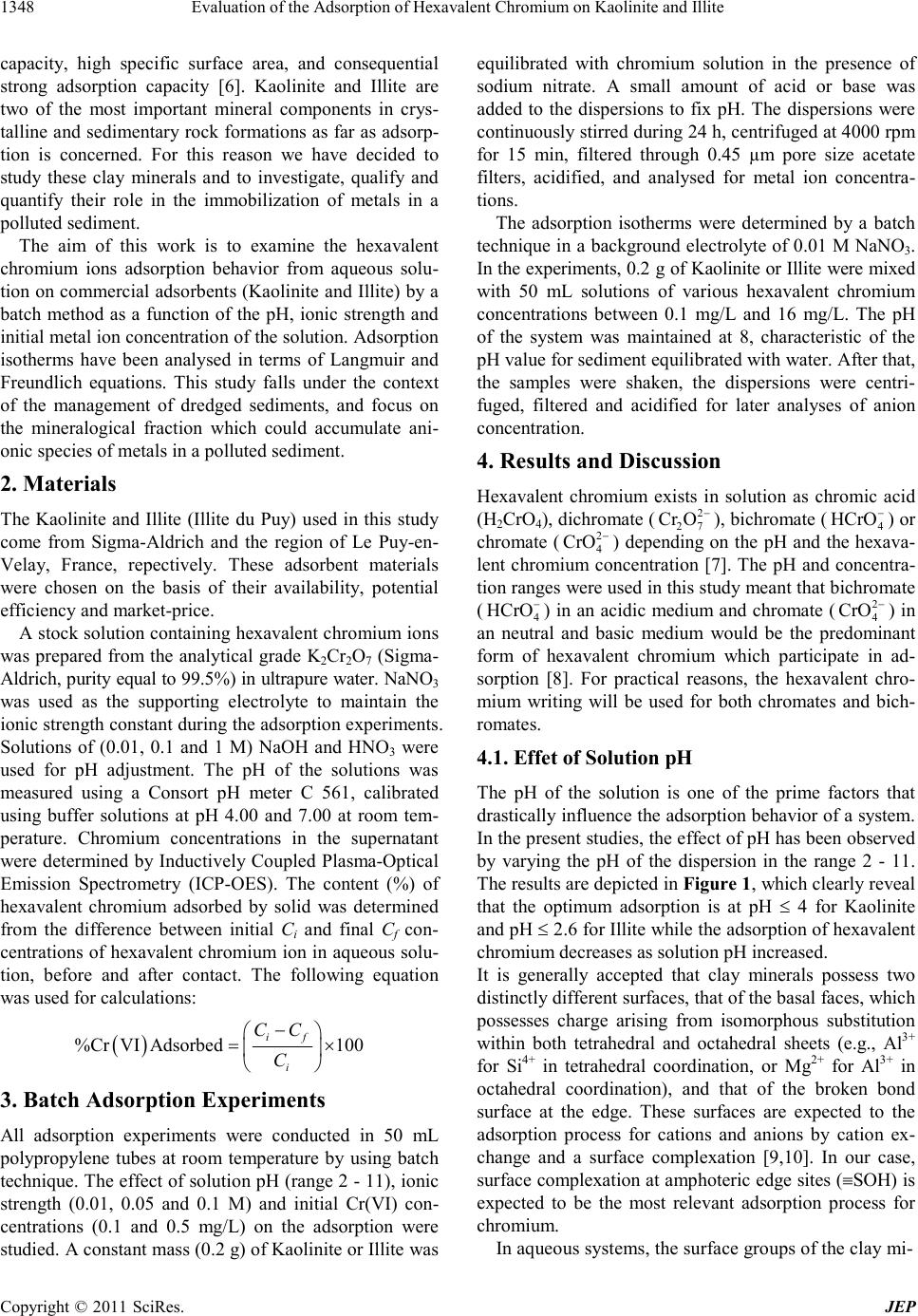
Evaluation of the Adsorption of Hexavalent Chromium on Kaolinite and Illite 1348
capacity, high specific surface area, and consequential
strong adsorption capacity [6]. Kaolinite and Illite are
two of the most important mineral components in crys-
talline and sedimentary rock formations as far as adsorp-
tion is concerned. For this reason we have decided to
study these clay minerals and to investigate, qualify and
quantify their role in the immobilization of metals in a
polluted sediment.
The aim of this work is to examine the hexavalent
chromium ions adsorption behavior from aqueous solu-
tion on commercial adsorbents (Kaolinite and Illite) by a
batch method as a function of the pH, ionic strength and
initial metal ion concentration of the solution. Adsorption
isotherms have been analysed in terms of Langmuir and
Freundlich equations. This study falls under the context
of the management of dredged sediments, and focus on
the mineralogical fraction which could accumulate ani-
onic species of metals in a polluted sediment.
2. Materials
The Kaolinite and Illite (Illite du Puy) used in this study
come from Sigma-Aldrich and the region of Le Puy-en-
Velay, France, repectively. These adsorbent materials
were chosen on the basis of their availability, potential
efficiency and market-price.
A stock solution containing hexavalent chromium ions
was prepared from the analytical grade K2Cr2O7 (Sigma-
Aldrich, purity equal to 99.5%) in ultrapure water. NaNO3
was used as the supporting electrolyte to maintain the
ionic strength constant during the adsorption experiments.
Solutions of (0.01, 0.1 and 1 M) NaOH and HNO3 were
used for pH adjustment. The pH of the solutions was
measured using a Consort pH meter C 561, calibrated
using buffer solutions at pH 4.00 and 7.00 at room tem-
perature. Chromium concentrations in the supernatant
were determined by Inductively Coupled Plasma-Optical
Emission Spectrometry (ICP-OES). The content (%) of
hexavalent chromium adsorbed by solid was determined
from the difference between initial Ci and final Cf con-
centrations of hexavalent chromium ion in aqueous solu-
tion, before and after contact. The following equation
was used for calculations:
%Cr VI Adsorbed100
if
i
CC
C
3. Batch Adsorption Experiments
All adsorption experiments were conducted in 50 mL
polypropylene tubes at room temperature by using batch
technique. The effect of solution pH (range 2 - 11), ionic
strength (0.01, 0.05 and 0.1 M) and initial Cr(VI) con-
centrations (0.1 and 0.5 mg/L) on the adsorption were
studied. A constant mass (0.2 g) of Kaolinite or Illite was
equilibrated with chromium solution in the presence of
sodium nitrate. A small amount of acid or base was
added to the dispersions to fix pH. The dispersions were
continuously stirred during 24 h, centrifuged at 4000 rpm
for 15 min, filtered through 0.45 µm pore size acetate
filters, acidified, and analysed for metal ion concentra-
tions.
The adsorption isotherms were determined by a batch
technique in a background electrolyte of 0.01 M NaNO3.
In the experiments, 0.2 g of Kaolinite or Illite were mixed
with 50 mL solutions of various hexavalent chromium
concentrations between 0.1 mg/L and 16 mg/L. The pH
of the system was maintained at 8, characteristic of the
pH value for sediment equilibrated with water. After that,
the samples were shaken, the dispersions were centri-
fuged, filtered and acidified for later analyses of anion
concentration.
4. Results and Discussion
Hexavalent chromium exists in solution as chromic acid
(H2CrO4), dichromate (), bichromate (4
2
27
Cr OHCrO
) or
chromate (2
4
CrO
) depending on the pH and the hexava-
lent chromium concentration [7]. The pH and concentra-
tion ranges were used in this study meant that bichromate
(4
HCrO
) in an acidic medium and chromate (2
4
CrO
) in
an neutral and basic medium would be the predominant
form of hexavalent chromium which participate in ad-
sorption [8]. For practical reasons, the hexavalent chro-
mium writing will be used for both chromates and bich-
romates.
4.1. Effet of Solution pH
The pH of the solution is one of the prime factors that
drastically influence the adsorption behavior of a system.
In the present studies, the effect of pH has been observed
by varying the pH of the dispersion in the range 2 - 11.
The results are depicted in Figure 1, which clearly reveal
that the optimum adsorption is at pH 4 for Kaolinite
and pH 2.6 for Illite while the adsorption of hexavalent
chromium decreases as solution pH increased.
It is generally accepted that clay minerals possess two
distinctly different surfaces, that of the basal faces, which
possesses charge arising from isomorphous substitution
within both tetrahedral and octahedral sheets (e.g., Al3+
for Si4+ in tetrahedral coordination, or Mg2+ for Al3+ in
octahedral coordination), and that of the broken bond
surface at the edge. These surfaces are expected to the
adsorption process for cations and anions by cation ex-
change and a surface complexation [9,10]. In our case,
surface complexation at amphoteric edge sites (SOH) is
expected to be the most relevant adsorption process for
chromium.
In aqueous systems, the surface groups of the clay mi-
Copyright © 2011 SciRes. JEP